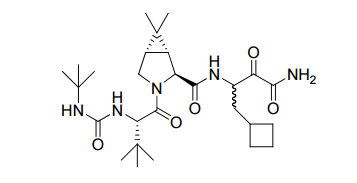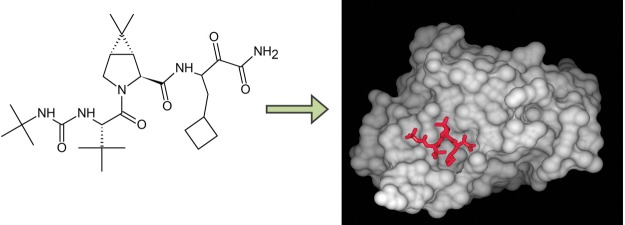Victrelis (boceprevir)
From Proteopedia
| Line 1: | Line 1: | ||
| - | + | ==Hepatitis C Virus== | |
The Hepatitis C virus (HCV) is a blood-borne, single stranded RNA virus. <ref>Centers for Disease Control and Prevention. (2015). Viral hepatitis - hepatitis C information. Retrieved from http://www.cdc.gov/hepatitis/hcv/index.htm</ref> Chronic Hepatitis C infection is a leading cause of mortality and morbidity across the globe, affecting between 130-170 million people. <ref>doi: 10.1093/cid/cis361</ref> The genome of HCV encodes a polyprotein precursor of approximately 3,000 amino acids, which are cleaved into 10 proteins by various proteases, one of which is the non-structural protein 3 (NS3) serine protease.<ref name="Line">PMID:21250386</ref> | The Hepatitis C virus (HCV) is a blood-borne, single stranded RNA virus. <ref>Centers for Disease Control and Prevention. (2015). Viral hepatitis - hepatitis C information. Retrieved from http://www.cdc.gov/hepatitis/hcv/index.htm</ref> Chronic Hepatitis C infection is a leading cause of mortality and morbidity across the globe, affecting between 130-170 million people. <ref>doi: 10.1093/cid/cis361</ref> The genome of HCV encodes a polyprotein precursor of approximately 3,000 amino acids, which are cleaved into 10 proteins by various proteases, one of which is the non-structural protein 3 (NS3) serine protease.<ref name="Line">PMID:21250386</ref> | ||
Revision as of 18:53, 5 December 2016
Contents |
Hepatitis C Virus
The Hepatitis C virus (HCV) is a blood-borne, single stranded RNA virus. [1] Chronic Hepatitis C infection is a leading cause of mortality and morbidity across the globe, affecting between 130-170 million people. [2] The genome of HCV encodes a polyprotein precursor of approximately 3,000 amino acids, which are cleaved into 10 proteins by various proteases, one of which is the non-structural protein 3 (NS3) serine protease.[3]
|
Victrelis
Victrelis (boceprevir) is an antiviral Hepatitis C medication approved by the United States Food and Drug Administration in 2011. Victrelis is an inhibitor of the NS3 serine protease. Inhibition of this protease prevents viral replication in Hepatitis C virus infected cells. [4]
Structure of Unbound Victrelis
The active ingredient in Victrelis, boceprevir, is an equal mixture of two diastereomers made of entirely organic molecules. The molecular formula is C27H45N5O5, and the molecular weight is 519.8 grams/mole. The structural formula is as follows: [4]
RNA Replication
Structure of Bound Victrelis & Mechanism of Action
Victrelis covalently, yet reversibly, binds to the NS3 serine protease at the residue. When bound to the NS3 serine protease, Victrelis also participates in between the side chains of specific amino acid residues on the NS3 serine protease: Asp168, Arg155, Gly137, Gln41, and Ala156.[5] The reactive carbonyl group at the beta-carbon position, located two carbons away from the terminal amine group, of Victrelis is attacked by the nucleophilic oxygen in Ser139 to create a covalent bond.[4][6]
Victrelis is a protease inhibitor. A protease is an enzyme that cleaves large polypeptides to create fragments that are small enough to be sequenced for effective replication.[7] Victrelis specifically inhibits the HCV NS3/4A protease, which is responsible for cleavage at four different sites along the polyprotein: NS3/NS4A, NS4A/NS4B, NS4B/NS5A, and NS5A/NS5B.[3] The active ingredient in Victrelis, boceprevir, covalently binds to the active site serine in the NS3 protease. The nucleophilic oxygen in the hydroxyl of the Ser139 group binds to the second carbon from the primary amine group, also known as the beta-carbon. When unbound, Ser139 forms hydrogen interactions with both His57 and Asp81 to create a [3]
In previous experiments, when any member of the catalytic triad was replaced by a different residue, cleavage at the NS3/NS4A, NS4A/NS4B, NS4B/NS5A, and NS5A/NS5B locations was inhibited.[3] By inhibiting the protease from cleaving the HCV at the NS3/NS4A location, the polyprotein is unable to be cleaved into smaller, functional proteins that compose replication machinery of HCV, thereby inhibiting viral replication.[8] In addition to viruses, mammals also utilize serine proteases to cleave lengthy polypeptides.[7] Victrelis was tested among several different mammalian proteases, including those that are vital for blood clotting, digestion, and antibody neutralization, and it was found to be exclusively selective for inhibition of the NS3 serine protease of HCV only.[9]
References
- ↑ Centers for Disease Control and Prevention. (2015). Viral hepatitis - hepatitis C information. Retrieved from http://www.cdc.gov/hepatitis/hcv/index.htm
- ↑ Averhoff FM, Glass N, Holtzman D. Global burden of hepatitis C: considerations for healthcare providers in the United States. Clin Infect Dis. 2012 Jul;55 Suppl 1:S10-5. doi: 10.1093/cid/cis361. PMID:22715208 doi:http://dx.doi.org/10.1093/cid/cis361
- ↑ 3.0 3.1 3.2 3.3 Lin C. HCV NS3-4A Serine Protease PMID:21250386
- ↑ 4.0 4.1 4.2 Merck & Co., Inc. (n.d.) Highlights of prescribing information. Retrieved from https://www.merck.com/product/usa/pi_circulars/v/victrelis/victrelis_pi.pdf
- ↑ Howe AY, Venkatraman S. The Discovery and Development of Boceprevir: A Novel, First-generation Inhibitor of the Hepatitis C Virus NS3/4A Serine Protease. J Clin Transl Hepatol. 2013 Sep;1(1):22-32. doi: 10.14218/JCTH.2013.002XX. Epub, 2013 Sep 15. PMID:26357603 doi:http://dx.doi.org/10.14218/JCTH.2013.002XX
- ↑ doi: https://dx.doi.org/10.2210/pdb2oc8/pdb
- ↑ 7.0 7.1 Voet, D., Voet, J., Pratt, C. (2013). Fundamentals of biochemistry: life at the molecular level (4th ed.). Hoboken, New Jersey: John Wiley & Sons, Inc.
- ↑ Howe AY, Venkatraman S. The Discovery and Development of Boceprevir: A Novel, First-generation Inhibitor of the Hepatitis C Virus NS3/4A Serine Protease. J Clin Transl Hepatol. 2013 Sep;1(1):22-32. doi: 10.14218/JCTH.2013.002XX. Epub, 2013 Sep 15. PMID:26357603 doi:http://dx.doi.org/10.14218/JCTH.2013.002XX
- ↑ Howe AY, Venkatraman S. The Discovery and Development of Boceprevir: A Novel, First-generation Inhibitor of the Hepatitis C Virus NS3/4A Serine Protease. J Clin Transl Hepatol. 2013 Sep;1(1):22-32. doi: 10.14218/JCTH.2013.002XX. Epub, 2013 Sep 15. PMID:26357603 doi:http://dx.doi.org/10.14218/JCTH.2013.002XX


